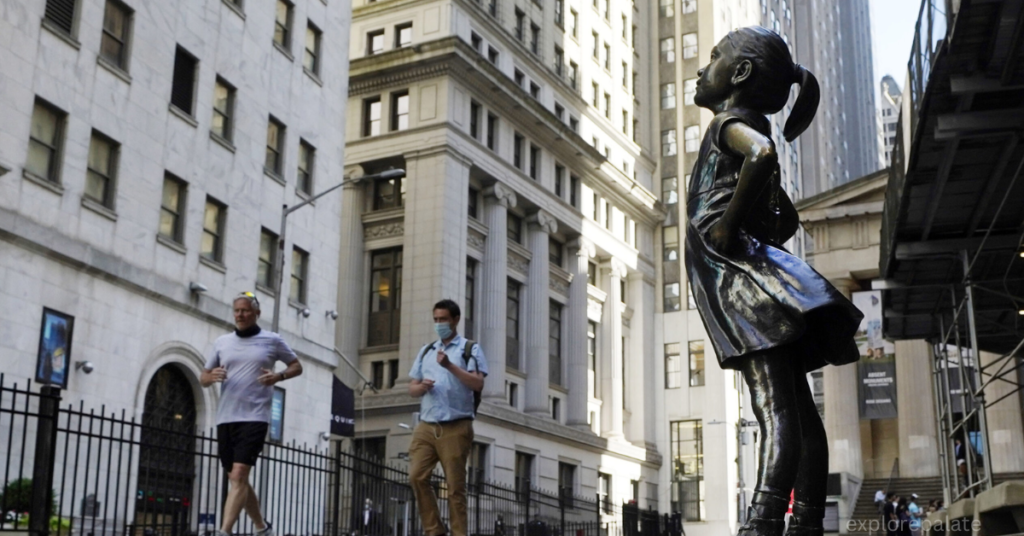Nestled in the bustling Financial District of New York City, just a stone’s throw away from Wall Street, the Charging Bull stands as a formidable bronze beast. My first encounter with this iconic statue was during a summer internship in finance; stepping out of the New York Stock Exchange, I was both shocked and nostalgic. There, amidst the throngs of people, it poses mightily at Bowling Green, near the northern tip of Broadway.
This location resonates deeply with New Yorkers and visitors alike, serving as a popular spot for taking pictures and reflecting on the American stock market. Over the years, I have seen it become a beacon for those seeking opportunity in the Big Apple, embodying the hustle and vibrancy of city life.
The creation of Arturo Di Modica, an Italian sculptor, the Charging Bull was introduced to the city streets illegally one night in 1989, following the Black Monday stock market crash. As a tour guide often recounted, it symbolizes aggressive financial optimism and prosperity, a universal symbol for Americans and all who work hard to succeed. This three-and-a-half-ton sculpture was initially removed by the police but soon found a permanent home outside the stock exchange due to public appeal.
The bull’s position, seemingly ready to charge, represents not just big business but also the indomitable spirit of the American people, battling through periods of financial tumult like those during COVID times. It’s fascinating how this piece of art has grown to attract millions of tourists from around the world—each visitor hoping to capture a photo with the famed Bull of Wall Street as a sign of the times when visiting the city.
How the Wall Street Bull Started: An Artist With Vision

The Charging Bull, a defining sculpture on Wall Street and a classic symbol of NYC embodies the indomitable spirit of the city. Arturo Di Modica, the sculptor and creator, poured his dreams and $360,000 of his own money into this bronze giant, intended to signify strength and optimism post-1987 stock market crash.
As an Italian-American hailing from Sicily and having become a well-known artist in Italy, Di Modica first started sculpting in his teens before ultimately being drawn to the vibrant energy of New York. Choosing the bull to represent “bullish” market trends, his work not only reflects a financial icon but also a site where artists, business professionals, and tourists find common ground in appreciation of both art and resilience.
Encountering the Charging Bull, whether as a local or a tourist, one can’t help but feel a part of its story—a tale of perseverance, vision, and a tribute to the American spirit. The bull, positioned in the bustling streets of modern SoHo, near Di Modica’s studio on Grand Street, continues to inspire those facing their everyday challenges. It’s a powerful motif not just for those invested in the fluctuating economy but for anyone who believes in the power of perseverance in the face of adversity.
The sculpture stands as a testament to fighting through the toughest of times, driven by the same dream and vision that started with a young artist in Italy, reaching out to capture the energy and spirit of a new home.
The Bull Arrives in Lower Manhattan
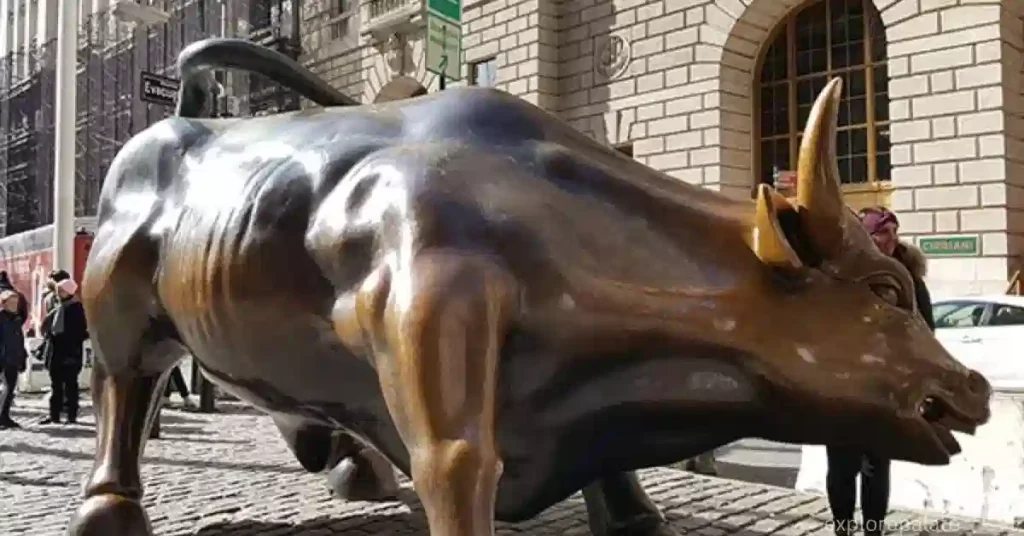
In the heart of Manhattan, just two blocks from the bustling New York Stock Exchange stands the iconic Charging Bull. Artist Arturo Di Modica initially placed this hefty sculpture, weighing about 7,000 pounds and stretching 11 feet in length, as a guerrilla-art style gift to the city. On Dec. 15, 1989, under a massive Christmas Tree near the stock exchange, Di Modica drove the bull on a flatbed truck and delivered it in secret during the holiday season.
This bold symbol of prosperity was not taken kindly by city officials, and the bull was soon moved to an impound lot by the police department. However, the locals immediately fell in love with the statue, and their outcry ultimately demanded that it be returned and rededicated at its new location on Broad Street, where it has lived since.
The New York Department of Parks and Recreation complied with the public’s demand, acknowledging the bull as a permanent, emblematic gift that retains its defiant spirit. Though in 2004, the statue was briefly put up for sale, no buyer emerged, leaving the grand artwork to remain an unsold yet cherished symbol. This transition from an unsanctioned installation to a recognized landmark encapsulates its status as a free gift that embodies New Yorkers’ promise of resilience and endurance. The Charge Bull continues to display the city’s prosperity, an enduring symbol that, despite its short life as an unofficial piece, has become a quintessential part of New York’s identity.
The Charging Bull
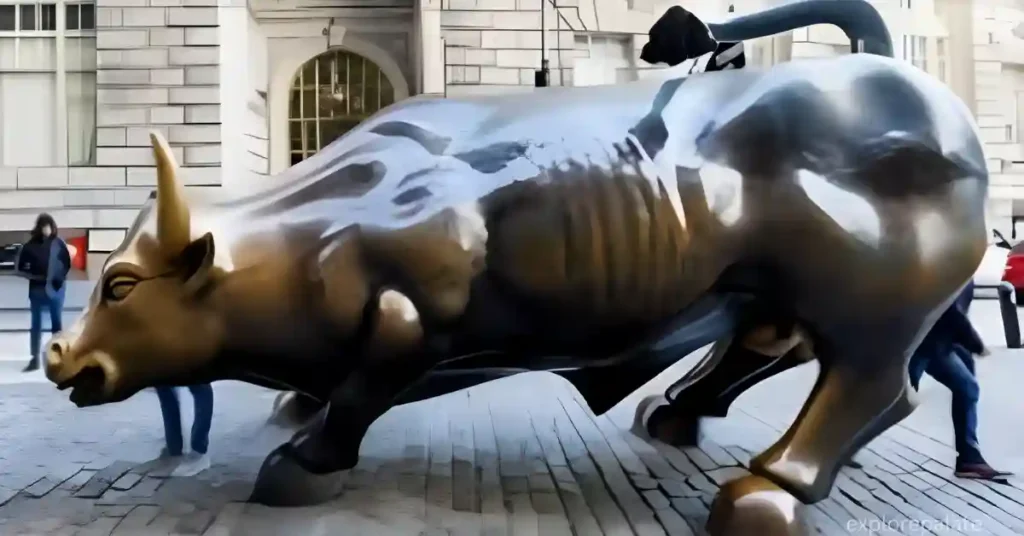
In the heart of New York, a sculpture known as the Charging Bull has become a symbol synonymous with Wall Street. Crafted by Arturo Di Modica, the bull was covertly installed outside the New York Stock Exchange on Dec. 15, 1989. Originating as an unauthorized gift to the city, it confronted the financial hub with a bold symbol of prosperity. Initially, city authorities weren’t inclined to keep it, yet public affection turned the famous piece into a permanent fixture. Sculpted in 1987, it was commissioned by no particular entity but rather sprung from Di Modica’s artistic vision, and approved post-installation by the community’s growing attachment.
The choice of a charging bull
Why a charging bull, one might ponder. This potent image was chosen as a symbol of a strong stock market; optimistic and confident, it represents the euphoric investor psychology that drives the market ever higher. Those familiar with Wall Street will understand this representation as quintessential of the attitudes of investors and participants in the thriving market economy they navigate. It’s not just a sculpture but a depiction of the driving force behind economic growth and investor optimism.
Although the sculpture’s arrival
December of 1989 was marked by the sculpture’s arrival, a surprise that sparked controversy yet eventually solidified its place in New York City’s landscape. Initially removed after its secretive installation by Arturo Di Modica, it was the New York City Parks Commissioner Henry Stern and then-Mayor Ed Koch who orchestrated its authorized return. With the backing of the Bowling Green Association, the Charging Bull found a permanent home at a triangle-shaped intersection near Broadway and Morris Street, enriching the Bowling Green Park area with a piece that melds art with public sentiment.
A Charging Bull, a Girl, and a Pug
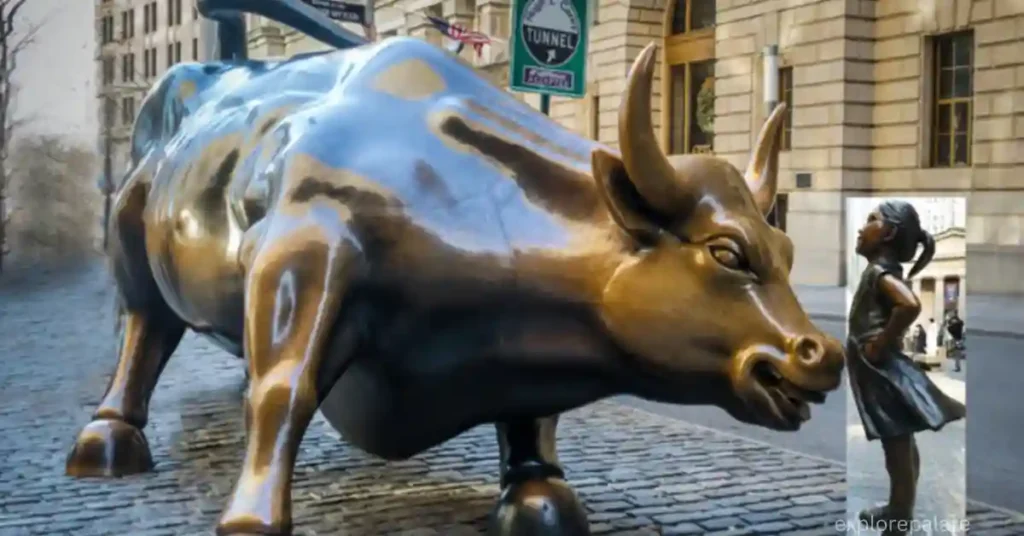
Surrounding the Charging Bull have been other figures: notably the Fearless Girl and the Pissing Pug. The Bronze statue of The Fearless Girl was erected to confront the bull on International Women’s Day by State Street Global Advisors, representing Gender Diversity Index ETF with ticker SHE—a move by sculptor Kristen Visbal to challenge norms and inspire leadership among women.
This installation sparked another controversy when artist Alex Gardega added the Pissing Pug, criticizing what he viewed as a corporate hijacking by the Fearless Girl. This trio captivated tourists, brokers, and traders, symbolizing a convergence of art, corporate interests, and public discourse. Despite being a temporary installation, vis-à-vis Mayor Bill de Blasio’s endorsement, this cluster near the NYSE has ignited extensive debates and social media discussions about the role of art in public spaces.
What Does the Charging Bull Represent?
The Charging Bull stands as a powerful statue symbolizing the vigor and resilience of Wall Street and by extension, America. Installed near the New York Stock Exchange, this significant work of art represents financial growth, prosperity, optimism, and the dynamic spirit of New York City.
Did They Move the Charging Bull?
Initially, the Charging Bull was a guerrilla art stunt, surreptitiously placed in front of the New York Stock Exchange in 1989. Due to its unplanned installation, it was moved to its permanent home at Bowling Green. The efforts to relocate it underscore its evolving role in the city’s culture.
Where to Find the Wall Street Bull

Located at Bowling Green Park, near the intersection of Broadway and Morris Street, the Charging Bull is nestled in a cobblestone plaza. This area bridges several historic sites including Trinity Church, and Federal Hall, and is in proximity to the Wall Street, Federal Hall, 9/11 Memorial & Museum, Battery Park, Statue of Liberty, and Ellis Island.
The Best Time to Visit the Bull
Visiting the Charging Bull can be most enjoyable early in the morning around 7-8 a.m. or after 6 p.m., when the crowds thin and you can enjoy a more peaceful experience. The soft glow of winter mornings sprinkled with snow or the serene coolness after dark are perfect for taking iconic pictures without the bustling crowds.
The Best Way to Visit the Charging Bull
To fully appreciate the Charging Bull’s significance, explore the surrounding Financial District. Start with this majestic sculpture, make your way past the New York Stock Exchange, and visit Federal Hall, Stone Street, and Trinity Church. Engaging with critically acclaimed tour guides can enhance your understanding of NYC’s rich history of commerce and art.
Has Fearless Girl Been Removed?
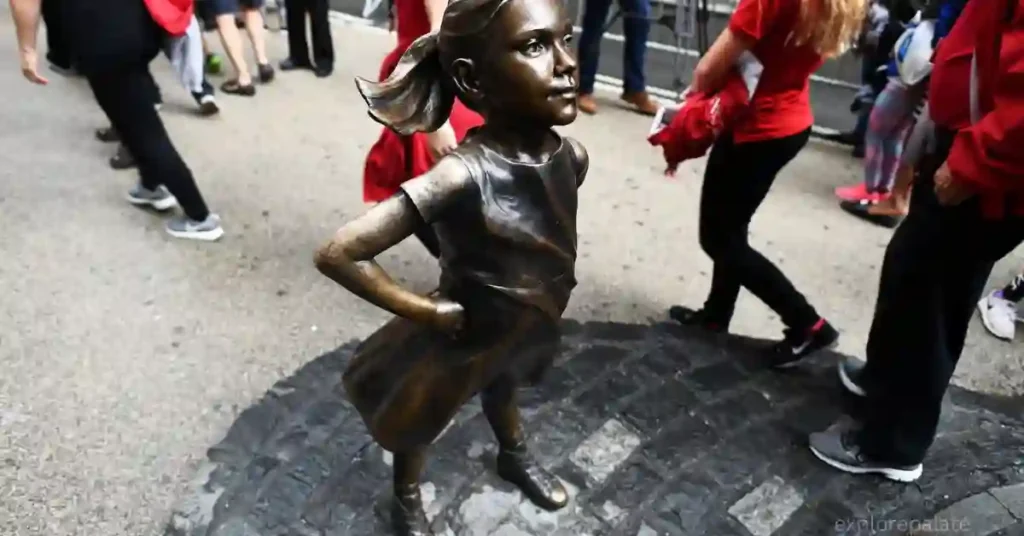
The Fearless Girl statue, initially positioned to face the Charging Bull, importantly symbolizing gender diversity on Wall Street, was removed from its original location. It now sits near the New York Stock Exchange, continuing its dialogue on corporate feminism.
The Bottom Line
The Charging Bull remains an icon of Wall Street and a heavily visited tourist attraction. It represents not only the power and financial might of New York City but also a quintessential visit point for those seeking a piece of America’s vibrant city’s prosperity and iconic cultural landmarks.
Conclusion
The Charging Bull of Wall Street is not just a piece of public art but a beacon of resilience and optimism in the heart of New York City’s Financial District. Its presence, originating from Arturo Di Modica’s unauthorized installation, transcends its status as a sculpture, embodying the unyielding spirit of the city and its citizens. From its covert arrival post-Black Monday to its acceptance as an emblem of prosperity, the bull symbolizes the undaunted pursuit of economic growth and financial strength.
As it stands mightily in Bowling Green, it continues to draw crowds, not only as a symbol of financial markets but as an icon of perseverance and determination, making it a profound touchstone for visitors and locals alike who seek inspiration in the bustling cityscape of New York.
You Might Also Like
FAQs
What is the story behind the bull in New York?
For two years, SoHo artist Arturo Di Modica had been working on his bronze and stainless steel sculpture out of his studio. The artwork was created in response to the 1987 stock market crash. According to Di Modica’s assistant at the time, it was a way for him “to encourage everybody to realize America’s power.”
Where is the Charging Bull in New York?
The Charging Bull is the name of the bronze sculpture of the animal its title depicts, located at Bowling Green near Wall Street in Manhattan. The bull was sculpted by artist Arturo Di Modica in the aftermath of the 1987 stock market crash, and publicly installed in 1989 at the end of Broadway and near Wall Street.
What is the meaning of Charging Bull and Fearless Girl?
As first placed, it faced Charging Bull, a much larger and heavier bronze statue that is 11 feet (3.4 m) tall and weighs 7,100 pounds (3,200 kg). Fearless Girl is meant to “send a message” about workplace gender diversity and encourage companies to recruit women to their boards.
What does the Charging Bull statue represent and why do people want to touch it?
Charging Bull was intended to inspire each person who came into contact with it to carry on fighting through the hard times after the 1987 stock market crash.




